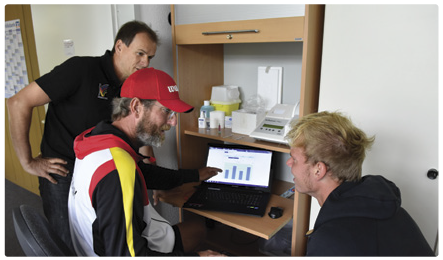Aug 31, 2018Managed Approach, Part 1
When athletes are being overworked, common consequences include illness, injury, or excessive fatigue. To reduce these negative effects of intensive training, strength coaches are tasked with implementing workload optimization strategies while still designing programs that maximize performance and allow athletes to train at high loads.
Finding and maintaining this delicate balance in workload management is both an art and a science. It’s a continuous process that usually requires four elements:
• Monitoring the work done by athletes on a daily basis (external load). This can include total time spent training and total distance traveled. In most cases, these metrics are assessed with tools like GPS tracking systems, heart rate monitors, or other wearables.
• Identifying the athletes’ responses to the work done (internal load). This can be found by asking them to provide their rate of perceived exertion (RPE) for each training session.
• Monitoring the athletes’ recovery and readiness. A common method for this is tracking subjective measures — such as fatigue, quality of sleep, stress levels, and mood — through daily wellness questionnaires.
• Analyzing the combined data and adjusting athletes’ training programs, recovery, and rest to minimize injury risk and optimize performance.
While the first three bullets are quite simple, the fourth step — interpreting the findings to make workload management decisions — is something many strength coaches find difficult. It can be made easier by closely evaluating the entire load management process and correcting any errors. There are six commonly made mistakes in this area. In Part 1 of this article, we present the first two:
1. USING THE WRONG TOOLS
In the current era of sport technology, it is easier than ever to use an improper device to assess a certain trait. If strength coaches are relying on the wrong tools, they won’t receive accurate information on how athletes are responding and adapting to training loads, making it difficult to manage workload effectively. For example, a GPS tracker is great for measuring a soccer player’s volume of high-speed running, but it will not provide any insight into how they tolerated the activity. Session RPE would be a better tool to monitor this metric.
What to do: Use technological devices for their intended purpose: measuring distances, power, and speed. To assess internal load, use low-tech — but scientifically validated — tools like session RPE and wellness questionnaires.
2. ILL-PREPARED ATHLETES
Athletes are often injured in the last period of a game, see performance drop at the end of a multi-day tournament, or become sick in the final stretch of training camp. Many times, these issues are predictable — they occur because athletes are not adequately prepared for the physical and psychological demands of the competitive task. This lack of readiness results in excessive fatigue, which in turn reduces motor control, impairs concentration, and increases vulnerability to injuries and illness.
What to do: To ensure athletes are prepared, start by accurately assessing the demands of the upcoming competition or training and identifying the key performance indicators (KPI). These are both objective (i.e., number of sprints, number of throws, and magnitude and duration of power output required by the activity) and subjective (i.e., what the athlete finds the hardest to do in the activity).
Then, administer KPI-specific tests to compare the athlete’s current level of fitness to the requirements of the competitive task. Afterward, progressively increase the athlete’s performance capacity to the necessary level required by the competition or training and KPIs.
Next week, we’ll delve into two more common errors.




